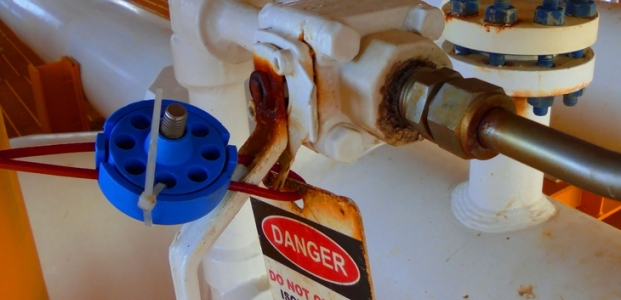
Interest Remains High in 'Game Changer' Z244.1-2016 Standard
The Z244.1-2016 standard attempts to help employers and safety managers prevent both violations and worker exposures to hazardous energy.
- By Jerry Laws
- Aug 01, 2017
Editor's note: This article originally used an incorrect number for this ANSI/ASSE standard, and that error appears in the article in the August 2017 print issue of OH&S. The numbering has been corrected in this online version of the article.
Safety professionals' interest in the ANSI/ASSE Z244.1-2016 standard, Control of Hazardous Energy—Lockout, Tagout And Alternative Methods, remains very high, based on the strong turnout for a session about it at ASSE's Safety 2017 conference in Denver. The session presenter was Todd C. Grover, global senior manager, Applied Safety Solutions, for The Master Lock Company, who earlier this year described the standard as updated, thoroughly revised, and more protective than the previous version. Grover, a member of the ANSI/ASSE Z244.1 Accredited Standards Committee, called it "a game changer" for U.S. and international safety professionals alike.
During his Safety 2017 talk and in a technical paper prepared for that conference, Grover discussed highlights of the new standard. "The intent has been to offer a plain language approach that describes how a range of well proven energy control practices can be accomplished and adapted to a wide range of industries. The 2016 standard was written to be scalable to meet the needs of both large and small companies with varying levels of technology present in their machinery and processes," he explained in the paper.
Published in December 2016, the standard contains much more about responsibilities—its Section 4 explains the responsibilities of users, personnel, and suppliers, the latter term defined as "an entity that designs, redesigns, fabricates, modifies, integrates, assembles or supplies machines, equipment or processes."
This section requires users to utilize machinery and processes that comply with Section 5, titled Design of Machinery/Equipment for the Control of Hazardous Energy. "This section provides guidance on roles and responsibilities of suppliers and builders to design for integral lockability, tamper resistance and the use of control reliable safeguarding technology when applicable," Grover wrote in the paper, adding that here, the standard says suppliers must document safety systems, conduct risk assessments, and explain how to minimize exposures during routine and repetitive servicing, repair, and maintenance work. "This results in end users being better prepared to finalize their own safe work procedures for personnel operating the equipment," he explained.
Section 6 covers the Hazardous Energy Control Plan, communication and training, program review, and management of change. All of the elements of the Hazardous Energy Control Plan are explained. In his talk, Grover explained that a systematic program for controlling hazardous energy should include:
- identifying responsibilities, tasks, hazardous energy sources, and energy isolating devices
- documenting procedures for controlling hazardous energy, procedures for shift change, procedures for user-directed lockout or tagout device removal, and use of outside services or contractor personnel
- implementation, both selecting and procuring the needed materials/hardware and communication and training
- program maintenance—including auditing, monitoring, and recordkeeping
The committee concluded that lockout should be the default protective measure used to control machinery or processes, and that lockout or tagout should be used unless the user can demonstrate that a well-established alternative method will offer effective protection; alternative methods should be used only after the hazards have been assessed and also documented, he explained.
He also explained that the committee acknowledges lockout isn't the solution in all cases, because it requires consistent human performance and is subject to proper training and verification of performance.
Grover said in an interview early this year that having the standard means machine designers can now emphasize that their equipment has been designed to the standard and can communicate the best ways to lock out that machine, as well as how to work and how to protect workers if maintenance must be done while it is powered.
OSHA representatives did participate on the committee, and Edward V. Grund, CSP, P.E., chairman of the committee, asked then-OSHA chief Dr. David Michaels by letter Dec. 9, 2016, to have OSHA move to adopt the new standard "by announcing that rulemaking will occur in the very near future to revise and update the existing federal standard, (29 CFR 1910.147)."
"In our opinion, the new ANSI Z244.1 (2016) Standard is significantly more protective, more reflective of current technology, and directly supports sound safety practices in American manufacturing," Grund wrote on behalf of the committee.
Lockout/tagout, or LOTO, ranked fifth among OSHA's most-cited standards during FY 2016, with the agency's CFR 1910.147 standard accounting for 3,414 citations as of Sept. 30, 2016, an OSHA enforcement official announced. It is consistently among the top ten.
The Z244.1-2016 standard attempts to help employers and safety managers correct their LOTO mistakes and prevent both violations and worker exposures to hazardous energy. There are more than 20 informational annexes with the standard that provide examples of risk assessment techniques and steps for shutting down and isolating machines or equipment, along with sample policies, guidance on using group lockout, and much more.
This article originally appeared in the August 2017 issue of Occupational Health & Safety.